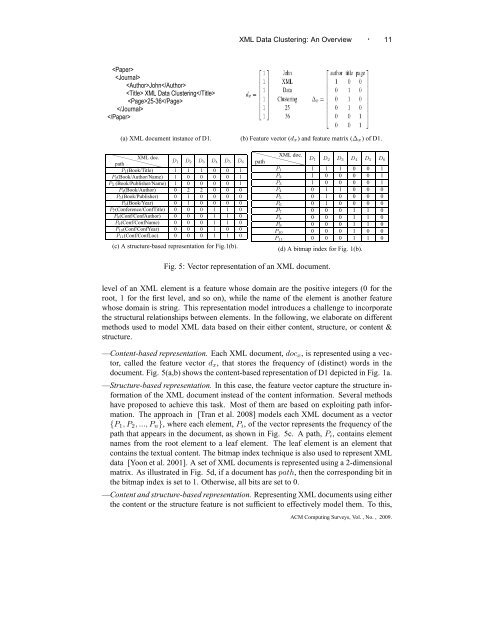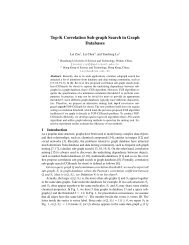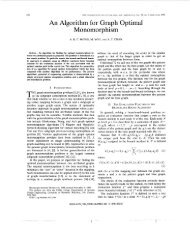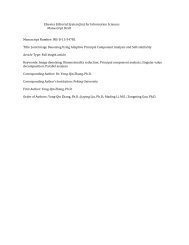PDF (1MB) - QUT ePrints
PDF (1MB) - QUT ePrints
PDF (1MB) - QUT ePrints
Create successful ePaper yourself
Turn your PDF publications into a flip-book with our unique Google optimized e-Paper software.
XML Data Clustering: An Overview · 11<br />
(a) XML document instance of D1. (b) Feature vector (d x) and feature matrix (∆ x) of D1.<br />
❳❳ ❳❳❳ XML doc.<br />
❳<br />
path ❳❳❳❳ D 1 D 2 D 3 D 4 D 5 D 6<br />
P 1(Book/Title) 1 1 1 0 0 1<br />
P 2(Book/Author/Name) 1 0 0 0 0 1<br />
P 3 (Book/Publisher/Name) 1 0 0 0 0 1<br />
P 4(Book/Author) 0 2 2 0 0 0<br />
P 5(Book/Publisher) 0 1 0 0 0 0<br />
P 6(Book/Year) 0 1 0 0 0 0<br />
P 7(Conference/ConfTitle) 0 0 0 1 1 0<br />
P 8(Conf/ConfAuthor) 0 0 0 1 1 0<br />
P 9(Conf/ConfName) 0 0 0 1 1 0<br />
P 10(Conf/ConfYear) 0 0 0 1 0 0<br />
P 11(Conf/ConfLoc) 0 0 0 1 1 0<br />
(c) A structure-based representation for Fig.1(b).<br />
❳❳ ❳❳❳ XML doc.<br />
❳<br />
path ❳❳❳<br />
❳<br />
D 1 D 2 D 3 D 4 D 5 D 6<br />
P 1 1 1 1 0 0 1<br />
P 2 1 0 0 0 0 1<br />
P 3 1 0 0 0 0 1<br />
P 4 0 1 1 0 0 0<br />
P 5 0 1 0 0 0 0<br />
P 6 0 1 0 0 0 0<br />
P 7 0 0 0 1 1 0<br />
P 8 0 0 0 1 1 0<br />
P 9 0 0 0 1 1 0<br />
P 10 0 0 0 1 0 0<br />
P 11 0 0 0 1 1 0<br />
(d) A bitmap index for Fig. 1(b).<br />
Fig. 5: Vector representation of an XML document.<br />
level of an XML element is a feature whose domain are the positive integers (0 for the<br />
root, 1 for the first level, and so on), while the name of the element is another feature<br />
whose domain is string. This representation model introduces a challenge to incorporate<br />
the structural relationships between elements. In the following, we elaborate on different<br />
methods used to model XML data based on their either content, structure, or content &<br />
structure.<br />
—Content-based representation. Each XML document, doc x , is represented using a vector,<br />
called the feature vector d x , that stores the frequency of (distinct) words in the<br />
document. Fig. 5(a,b) shows the content-based representation of D1 depicted in Fig. 1a.<br />
—Structure-based representation. In this case, the feature vector capture the structure information<br />
of the XML document instead of the content information. Several methods<br />
have proposed to achieve this task. Most of them are based on exploiting path information.<br />
The approach in [Tran et al. 2008] models each XML document as a vector<br />
{P 1 , P 2 , ..., P n }, where each element, P i , of the vector represents the frequency of the<br />
path that appears in the document, as shown in Fig. 5c. A path, P i , contains element<br />
names from the root element to a leaf element. The leaf element is an element that<br />
contains the textual content. The bitmap index technique is also used to represent XML<br />
data [Yoon et al. 2001]. A set of XML documents is represented using a 2-dimensional<br />
matrix. As illustrated in Fig. 5d, if a document has path, then the corresponding bit in<br />
the bitmap index is set to 1. Otherwise, all bits are set to 0.<br />
—Content and structure-based representation. Representing XML documents using either<br />
the content or the structure feature is not sufficient to effectively model them. To this,<br />
ACM Computing Surveys, Vol. , No. , 2009.












